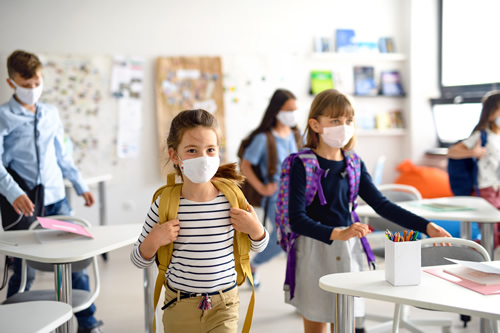Currently, many parents are using a variety of websites, emails, and communication to learn about important updates. This portal allows all information to be in one place to increase ease of use for both parents and faculty.
Digital signage and PA systems
The CDC has also recommended that schools “post signs in highly visible locations (e.g., school entrances, restrooms) that promote everyday protective measures and describe how to stop the spread of germs (such as by properly washing hands and properly wearing a cloth face covering).” School buildings are full of screens, from desktops to TVs, which administrators can and should leverage to display this information as well as other important announcements.
Plenty of schools have their own personal channel or CCTV that can be used to communicate this information to staff and students instead of paper. This digital signage is a better option than paper because the information can be easily edited and updated in real time, and it decreases the need for people to handle and distribute paper that they have touched throughout the school.
By utilizing technology the school already has, administrators can help keep students and staff vigilant when it comes to operating during COVID-19: The CDC recommends that schools “broadcast regular announcements on reducing the spread of COVID-19 on PA systems.” This is a simple way to reinforce proper procedures and safety precautions amongst students and staff. This same information can also be added to the aforementioned portals for transparency and consistency.
Thermal imaging
One vital step to decreasing the spread of COVID-19 is detecting who is sick or potentially sick. This is why the CDC guidelines recommend, “if feasible, conduct daily health checks (e.g., temperature screening and/or or symptom checking) of staff and students.” This can be difficult, especially for schools with large numbers of students and staff members, however technology can help manage this process.
Thermal imaging cameras can help detect anyone who may potentially be sick by checking their temperature. This automated and non-intrusive detection of any abnormal human body temperature allows administrators to identify people who may need additional screening to assess if the individual is experiencing any symptoms of COVID-19 or has a fever.
Access control
Access control is another way to potentially decrease the exposure of COVID-19. The CDC recommends reducing any unnecessary gatherings and limiting interactions, so it’s important to make sure no unauthorized people are entering school premises and that when people do enter the building that they can do so with the least amount of contact with other people or frequently touched objects.
One way to make access control automatic and touchless is to use facial recognition. With facial recognition, students and staff can be recognized upon arrival and be let into the building without assistance. Facial recognition can also be used throughout the school to improve school safety by alerting staff if any unauthorized individuals are detected inside the premises.
A unified system
All of these different technologies are useful, but they can be even more powerful when tied together on one platform. For many organizations, systems function individually meaning countless alarms, notifications and data to keep track of. Unfortunately, this isolation of systems oftentimes results in inefficient management and decreased safety. This unification makes these separate systems easy to manage by allowing them to be monitored all in one place, improving both efficiency and safety.
Although circumstances have changed this school year, the main goal of providing a safe environment for students and staff has not. With the right plan and effective tools, administrators can plan for a safe reopening this fall.
- 5 ways technology can help schools meet CDC guidelines this fall - July 20, 2020
- How to thoughtfully implement panic buttons into your school safety plan - April 15, 2020

